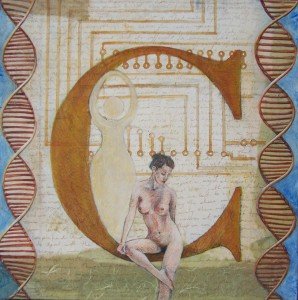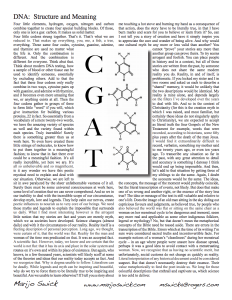This piece is a large movable group of 8 paintings. This configuration is approximately 6 feet x 9 feet high. Read the full essay that describes the work.
Contact me for more info about purchasing this work



Read essay about this piece DNA structure and meaning
DNA: Structure and Meaning
Four little elements, hydrogen, oxygen, nitrogen and carbon combine together to create four special building blocks. Of those, only one is not a gas: carbon. It makes us solid matter.
Four little codons strung together. That’s it. That’s what we are reduced to. That makes up everything, you, me, a fish, a tree, everything. These same four codes, cytosine, guanine, adenine, and thymine are used no matter what the life is. Only the combination is different. And the combination is different for everyone. Think abut that. Think about modern DNA testing, how a sample of blood or other tissue can be used to identify someone, essentially by excluding others. Add to that the fact that these four codons only really combine in two ways, cytosine pairs up with guanine, and adenine with thymine, and it becomes even more amazing that we, or anything exists at all.
Then the four codons gather in groups of three to form little “word” if you will, which give instruction for building various proteins, 22 in fact. So essentially from a vocabulary of a mere twenty-two words, we have the amazing variety of species as well and the variety found within each species. Truly incredible! Surely there is something greater than us at work here. To even have created these little strings of molecules, to know how to put them together in a meaningful fashion; to know that in fact there ever could be a meaningful fashion. It’s all really incredible, yet here we are. It’s all so unbelievable and so magnificent, is it any wonder we have this poetic mystical need to explain and deal with our situation. Otherwise, we are left to sit in awe paralyzed by the sheer unfathomable vastness of it all. Surely there must be some universal consciousness at work here, some level of creation that we can never comprehend. And so we in our inability to deal with the incredible scope of our circumstance, develop myth, lore and legends. They help calm our nerves, create poetic influences to nourish us to very core of our beings. We need these myths and legends to explain the impossible that surrounds us daily. What I find most interesting however is the arrogant little notion that my stories are fact and yours are merely myth, which we as societies have developed.
Science changes (almost daily) and with it the circumstances of our reality. Reality itself is a fleeting description of personal perception. Long ago, we thought, were certain of it, that the world was flat. Reality for the man and woman of the time was predicated on that. It was an accepted fact. A scientific fact. However, today, we know and are certain that the world is not flat: that it has its axis and place in the solar system and rotates on it’s own and within its place of existence. But again, who knows, in a few thousand years, scientists will likely scoff at some of the theories and ideas that our reality today accepts as fact. And we recognize that. Why is dogma unable to follow. Literalism can be deadly. While legends and myth can be inspiring and beautiful, why do we try to force them to be literally true to be inspiring and beautiful. Are we unable to learn otherwise? If I tell you a story about me touching a hot stove and burning my hand as a consequence of that action, does the story have to be literally true, in that I have burn marks and scars for you to believe or learn from it? So, can I not tell you a story of creation and have it simply inspire you to appreciate the awe and wonder of being alive.
And why would one cultural myth be any more or less valid than another? You cannot “prove” your stories any more than another group can prove theirs. To try seems arrogant and foolish. You can place people in history and in a context, but all of these stories are written from the past, by someone who does not share the same modern reality you do. Reality, in and of itself, is problematic. If you locked my sister and I in two rooms and asked us each to describe a “shared” memory, it would be unlikely that the two descriptions would be identical. My reality is mine alone, and depends largely on the filters I’ve developed over the years to deal with life. And so in the context of Christianity (for this is the creation myth in which I was raised, and most familiar, but certainly these ideas do not singularly apply to Christianity), we are expected to accept as literal truth the four Gospels of the New Testament for example, words that were recorded, according to historians, some fifty plus years after the death of the man Jesus. I would find it extraordinarily difficult to record, verbatim, something my mother said to me twenty years ago, or even ten years ago. To transcribe any situation so far in the past, with any great attention to detail and accuracy is something I daresay I think would end up being impossible. And then, let’s add to that situation by getting three of my siblings to do the same. Again, I doubt the accounts would be the same. The ideas, the concepts, the message of the moment would probably coincide, but the literal transcription of events, not likely. But does that make one of us wrong and another right, or the essence of the story less true? The idea or message of the text is still valuable and relative to one’s life. Does the image of an old man sitting in the sky doling out capricious favours and judgments, as believed true, by people who also believed the world was flat or sitting on the same chair as a woman on her menstrual cycle to be dangerous and immoral, seem any more real and applicable as some other indigenous folklore, legend or mythology? No, but that doesn’t mean the metaphorical concepts of the Bible need be tossed aside. There are errors in the transcription of the Bible. Errors which at the time of its writing I’m sure were considered sacred truths and incontrovertible facts. For example notions of a woman’s “cleanliness” during her menstrual cycle – in an age where people were unsure how disease spread, perhaps it was a good idea to avoid contact with a menstruating woman. Now, we recognize that as having no scientific merit, but unfortunately, social customs do not change as quickly as reality. Literal interpretation of any historical document could be considered suspect. But that doesn’t necessarily destroy their essence. Their value metaphorically to feed the poet inside us. We long for those colourful descriptions that enthrall and captivate us, which science is too cold to deliver.